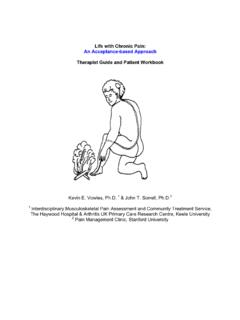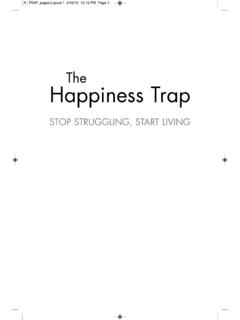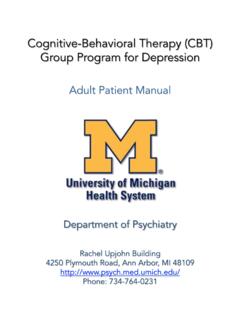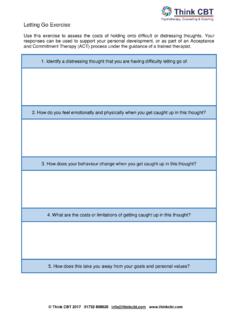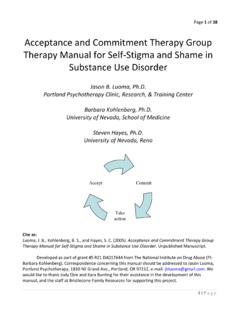Transcription of Seven Values “Greatest Hits” - Portland Psycho
1 1 Portland Psychotherapy 2016 Seven Values Greatest Hits : Our Favorite Values Exercises from acceptance and commitment therapy Jenna T. LeJeune, Jason Luoma, Portland Psychotherapy Clinic, Research and Training Center Table of Contents Values Sweet Spot ..2 Values Card Sort Instructions ..5 Write Your Own Commandments ..8 Tombstone exercise ..9 Eulogy exercise ..11 Trying on a Value ..14 The Appendix A: Values card sort cards ..18 Acknowledgements: These are our Seven favorite Values exercises based on work with hundreds of clients and use in workshops and trainings. Most of these exercises originated from others. Rather, what we have tried to do is take some of our favorite ACT Values exercises and write some scripts for how they might be used in therapy . It is our sincere intention to give credit to the original sources here but if there is something in this handout that we have inadvertently not given proper credit to, please let us know so we can correct that error or omission.
2 2 Portland Psychotherapy 2016 Values Sweet Spot Adapted from Wilson, & Sandoz, E. K. (2010). Mindfulness, Values , and the therapeutic relationship in acceptance and commitment therapy . In S. Hick & T. Bein (Eds.) Mindfulness and the therapeutic relationship. New York: Guilford Press. 1. Choose valued domain to focus on: Before you begin this eye s closed exercise, you ll want to have the client choose one domain of their life that they would like to focus on. You might suggest a few domains such as work/education, relationships, leisure, personal growth/health and have them find one they would like to focus on. A domain in which the client has lost touch with their Values is often a good place to focus for this exercise. 2. Provide explanation and get permission: Provide some brief explanation of what a sweet spot is. Your explanation might look something like this: Would you be willing to do an eyes-closed exercise with me for a bit?
3 You ve already talked about wanting to make some changes in X (work/education, relationships, leisure, health, etc.). We re going to focus on that particular area of your life for this exercise. And in this exercise I m going to have you come into contact more fully with what you d really value in that domain in your life. Does that sound like something you d be willing to try? Great, so I m going to lead you through an exercise where I ll ask you to identify a sweet spot in that domain in your life. A sweet spot is a little hard to describe with words. It s more of a felt thing. It s that place, that moment in time where you get that heartfelt sense of Ah, this is it. There is something very complete and precious in that moment. You might feel very alive in that moment. It s a moment that is complete, nothing needs to be added to or taken away from it. Sometimes people find that there is a strong emotional tenderness that you experience when you come into contact with your sweet spot even though it s hard to describe why that moment is so special.
4 And a sweet spot can be a very simple sort of thing. Let me give you an example [give example from your own life in detail, noting the different sensory aspects of the scene such as: So in my life, in that area of health/personal growth domain I see myself on a cold, foggy morning, it s dark outside, my dog Grace and I are at the corner of 15th and Highland about of our way through our morning exercise, I am look down at her and she s looking up at me, wagging her tail. It s dark except the warm glow from the street light she s standing under. That moment needs nothing. I don t need anyone else, it doesn t need to be anything else in that moment. It is complete. For me, that moment is about being committed, which is what I value in the area of health.] Your sweet spot doesn t have to be like mine. There is no right or wrong here. It can be very simple, but think about something specific, a specific instance of something sweet.
5 It could be a specific scene of you out gardening, the feeling of dirt on your hands, the smell of the earth, the sound of the birds on a warm summer morning in your garden, or it could be that 3 Portland Psychotherapy 2016 moment at the end of your yoga practice while you are resting in shavasana or when you re watching your kids as they play and they are so completely involved in what they are doing they don t see you, but you re just absorbing the moment of watching them play. I would invite you to just encounter that sweet spot to the best of your ability. Again, there is no right or wrong experience here. Just see what comes up for you. Any questions? 3. Lead client through eyes-closed exercise: The below script is just a general guide. The main things to remember are to go slow, linger, help the client actually feel what it is like for them in that sweet spot. This part of the exercise can last anywhere from 5-10 minutes or even longer.
6 So if you re willing, I d like you to allow yourself to sit comfortably, maybe with your feet on the ground. Just gently, gently let your eyes close. [lead them through a fairly extensive centering exercise] Now I d like you to imagine that in front of you there is a file cabinet. There are four drawers in this file cabinet. One drawer is labeled Work/Education, another is labeled Relationships , Leisure and finally Personal Growth/Health. [use whatever domains a relevant to your client] First just notice what it feels like to stand in front of this file cabinet and choose which drawer you will open. Do you feel a longing to open one drawer? A resistance to opening another? Just notice what shows up for you. Now I d like you to imagine that you open the drawer for that domain that you ve chosen to work on. Feel the weight to the drawer in your hand.
7 Hear it open. Notice what your heart is doing right now, what sensations are going through your body, what thoughts your mind is giving you. And then you reach in to that drawer and in the drawer is a picture. It s a picture of you during that sweet spot in that domain of your life. Slowly reach into the drawer and pull out that picture of you in that moment that represents your sweet spot. Take in that whole scene. Notice what is happening there. Look at your face in that scene. Notice any expressions that person in the scene is making. Now see if it s possible to go from looking at that picture, to now being in that scene. You are transported into being in that body of the you that was there in that scene. Look down at your hands and notice what they look like at that age. Look out from behind those eyes and notice what you see. Notice the smells around you. Notice what the air feels like.
8 Now turn inward and notice what you feel in that body that is in the scene. What emotions are there? Really see if you can savor what it is like to be you in this scene. And now, really experience how you are in that moment. Notice the quality of your actions. As you are standing in that place, notice what is important to you right at that moment, that moment that doesn t need anything else in order to be complete. In that moment, you don t need to be anything else in order to be complete. And now I m going to ask you to gently bring you awareness back to your body right now in this moment. Keeping your eyes closed, just see if you can be present with what you are experiencing right now. Most people find this exercise brings up a whole range of feelings, sometimes pleasant maybe warm and loving, sometimes quite painful. And for others they don t have any strong feelings at all, it s just a more subtle sense.
9 Just take a minute or to 4 Portland Psychotherapy 2016 here with your eyes closed to you are consider what those feelings tell what truly matters to you. What sort of person you want to be in that domain of your life. What you want your life to stand for in that domain of your life. What, if you were free to choose, you would actually choose to important in that domain. What did you notice about what kind of a person you are when you are at the most perfect sweet spot? Just notice. 4. Debrief: After asking the client to open their eyes, but still maintaining a quiet mindfulness, allow your client to share what came up for them. Don t focus on trying to name a value or come to some answer. Your job is simply to be present and see if you can notice hints of that sweet spot emerging. Your instructions to the client might include some of the following: Now, as best as you can, I want you to see if you could bring that picture to life here in the room so I can share it with you.
10 I want hear, feel, and see that sweet moment. I want to know who you are in that moment. What are the qualities that make up that sweet spot? Just notice the color and nuance of it. It doesn t even need to make sense. You don t need to explain it or have me necessarily understand it. Just give voice to what you would so deeply care about. 5. Conclude: You can wrap up by talking about how Values are found in places like that sweet spot. There is a palpable quality to them. Values aren t something that are just named, they are a quality of action, a way of being in the world. So if the client is present, they might be able to notice qualities of that sweet spot in various aspects of their life and if they do, it might indicate that they are headed in a valued direction. 5 Portland Psychotherapy 2016 Values Card Sort Instructions Adapted from Veage, S., Ciarrochi, J., & Heaven, P. (2014).
